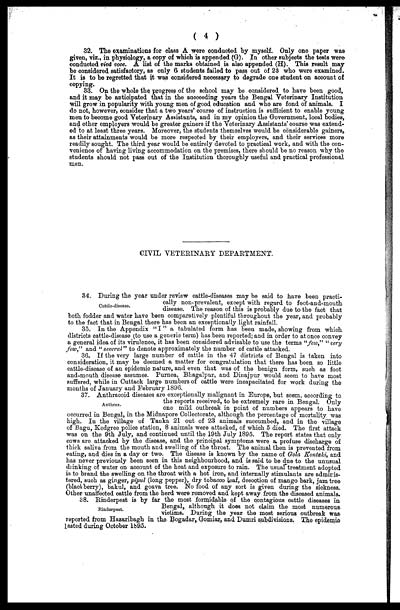Medicine - Veterinary > Civil Veterinary Departments > 1895-1951 - Annual report of the Civil Veterinary Department, Bengal > 1895-1896 - Annual report of the Civil Veterinary Department, Bengal, for the year 1895-96 > Annual report of the Civil Veterinary Department, Bengal, for the year 1895-96
(8) Page 4
Download files
Individual page:
Thumbnail gallery: Grid view | List view

(4)
32. The examinations for class A were conducted by myself. Only one paper was
given, viz., in physiology, a copy of which is appended (G). In other subjects the tests were
conducted vivd voce. A list of the marks obtained is also appended (H). This result may
be considered satisfactory, as only 6 students failed to pass out of 23 who were examined.
It is to be regretted that it was considered necessary to degrade one student on account of
copying.
33. On the whole the progress of the school may be considered to have been good,
and it may be anticipated that in the succeeding years the Bengal Veterinary Institution
will grow in popularity with young men of good education and who are fond of animals. I
do not, however, consider that a two years' course of instruction is sufficient to enable young
men to become good Veterinary Assistants, and in my opinion the Government, local bodies,
and other employers would be greater gainers if the Veterinary Assistants' course was extend-
ed to at least three years. Moreover, the students themselves would be considerable gainers,
as their attainments would be more respected by their employers, and their services more
readily sought. The third year would be entirely devoted to practical work, and with the con-
venience of having living accommodation on the premises, there should be no reason why the
students should not pass out of the Institution thoroughly useful and practical professional
men.
CIVIL VETERINARY DEPARTMENT.
Cattle-disease.
34. During the year under review cattle-diseases may be said to have been practi-
cally non-prevalent, except with regard to foot-and-mouth
disease. The reason of this is probably due to the fact that
both fodder and water have been comparatively plentiful throughout the year, and probably
to the fact that in Bengal there has been an exceptionally light rainfall.
35. In the Appondix "I" a tabulated form has been made, showing from which
districts cattle-disease (to use a gonerio term) has been reported; and in order to at once convey
a general idea of its virulence, it has been considered advisable to use the terms "few" "very
few" and "several" to denote approximately the number of cattle attacked.
36. If the very large number of cattle in the 47 districts of Bengal is taken into
consideration, it may be deemed a matter for congratulation that there has been so little
cattle-disease of an epidemic nature, and even that was of the benign form, such as foot
and-mouth disease assumes. Purnea, Bhagalpur, and Dinajpur would seem to have most
suffered, while in Cuttack large numbers of cattle were incapacitated for work during the
months of January and February 1896.
Anthrax.
37. Anthracoid diseases are exceptionally malignant in Europe, but seem, according to
the reports received, to be extremely rare in Bengal. Only
one mild outbreak in point of numbers appears to have
occurred in Bengal, in the Midnapore Collectorate, although the percentage of mortality was
high. In the village of Tanka 21 out of 23 animals succumbed, and in the village
of Bagu, Kedgree police station, 8 animals were attacked, of which 5 died. The first attack
was on the 9th July, and continued until the i9th July 1895. The report states that only
cows are attacked by the disease, and the principal symptoms were a, profuse discharge of
thick saliva from the mouth and swelling of the throat. The animal then is prevented from
eating, and dies in a day or two. The disease is known by the name of Gola Kontaki, and
has never previously been seen in this neighbourhood, and is said to be due to the unusual
drinking of water on account of the heat and exposure to rain. The usual treatment adopted
is to brand the swelling on the throat with a hot iron, and internally stimulants are admiris-
tered, such as ginger, pipul (long pepper), dry tobacco leaf, deeoction of mango bark, jam tree
(blackberry), bakul, and goava tree. No food of any sort is given during the sickness.
Other unaffected cattle from the herd were removed and kept away from the diseased animals.
Rinderpest.
38. Rinderpest is by far the most formidable of the contagious cattle diseases in
Bengal, although it does not claim the most numerous
viotims. During the year the most serious outbreak was
reported from Hazaribagh in the Bogadar, Gomiar, and Dumri subdivisions. The epidemic
lasted during October l895.
Set display mode to: Large image | Zoom image | Transcription
Images and transcriptions on this page, including medium image downloads, may be used under the Creative Commons Attribution 4.0 International Licence unless otherwise stated. ![]()
| Permanent URL | https://digital.nls.uk/75720143 |
|---|
| Description | Title on spine: Civil Veterinary Department Bengal. Reports 1895-96. |
|---|---|




